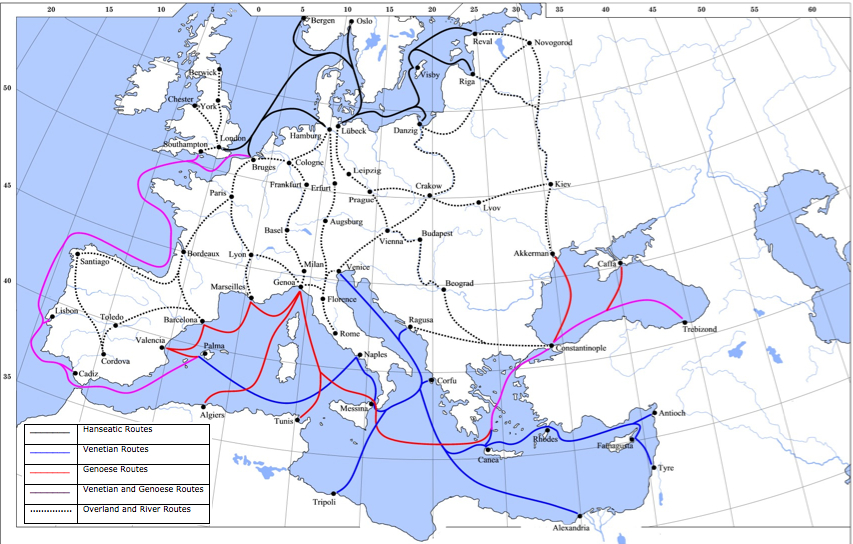The plague, named the Black Death by later historians, had a devastating effect on the European population in the fourteenth century.
Overview
The diffusion of crops and pathogens, including epidemic diseases like the bubonic plague, often occured along trade routes.
The bubonic plague - named the Black Death by later historians - was caused by the yersinia pestis bacteria, which lived in rodent populations and was spread by fleas that had bitten infected animals.
Once the plague transferred to animals that were in close contact with humans and to humans themselves, it began to spread along established trade routes.
It is difficult to measure the exact human cost of the plague due to limited records from the historical period.
Most historians think that the plague killed somewhere between 30% and 60% of Europe’s population between 1347 and 1351.
Trade and disease
The spread of disease and trade went hand in hand, and no event illustrates this relationship better than the outbreak of bubonic plague in the mid-14th century, an event more commonly known today as the Black Death.
In a passage from his book titled The Decameron, Florence, Italy resident Giovani Boccaccio described the Black Death, which reached Florence in 1348:
It first betrayed itself by the emergence of certain tumors in the groin or the armpits, some of which grew as large as a common apple, others as an egg, some more, some less . . .
From the two said parts of the body this deadly [bubo] soon began to propagate and spread itself in all directions indifferently; after which the form of the malady began to change, black spots or livid making their appearance in many cases on the arm or the thigh or elsewhere, now few and large, then minute and numerous.
Historians and epidemiologists are confident that the Black Death originated in east-central Asia, which raises the question: How did the plague make it to Europe?
To understand how the plague spread, we need to understand how the disease was transmitted, along with the broader economic and political contexts that made its spread possible.
By the 1300s, several Italian city-states had established trade relationships throughout the Mediterranean and Black Seas. The Genoese had a successful colony at the city of Kaffa on the Crimean Peninsula, which they held with the permission of the Mongol rulers of the region. In 1344, disagreements between the Genoese and the Mongols led to conflict.

Note how much of Europe was linked via trade routes. Compare the map below showing the spread of plague to the routes shown here to see how the plague spread north from the Mediterranean ports. Image credit: Wikimedia commons.
In 1346, the plague reached the Mongol soldiers who were besieging the city of Kaffa. Stories from the period tell us that the plague devastated the Mongol army, forcing it to give up the siege. Some of these stories also include a more gruesome detail: the Mongols catapulted the dead bodies of the soldiers who died of the plague into the city.
Whether the Mongols intended to spread the disease, and whether the story is even true, is not clear. What is clear is that some residents of Kaffa were infected with plague.
The plague continued to travel through Asia, eventually hitting major cities such as Baghdad and Constantinople. From there, it traveled to Alexandria in Egypt, Damascus in Syria, and down the Red Sea to Mecca. From there it almost certainly entered the Indian Ocean trade networks. The plague also traveled with Genoese merchants back to Italy, first to the port of Messina in 1347, and then north through Europe over the next several years.

The first cases of plague in Europe were spread by Genoese traders returning from Kaffa. Note that the earliest areas of plague were around Constantinople and in the islands of Sicily, Sardinia, and Corsica, and also the port of Marseille. All of these would have been stops for Genoese ships on their way from Crimea to Genoa. (Genoa is on the coast roughly between Marseille and Milan.) Image credit: Wikimedia.
Taking both maps together, does the spread of the plague through Europe seem to have any relationship with important trade routes?
No comments:
Post a Comment